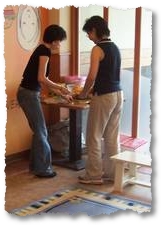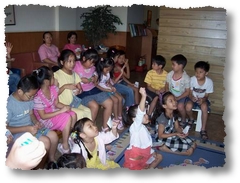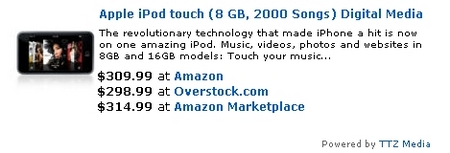 Tonight’s episode of Seinfeld was a rerun from the mid-90s when Jerry receives a large check (so large that Kramer is surprised) for his performance . It’s only part one of a two-parter. But it got me wondering about what most people do when they receive a windfall. Management of your new found resources can be a problem; and it’s a problem that I share with those who get annual bonuses or special rewards, prizes, unexpected windfalls, inheritances, etc..
Tonight’s episode of Seinfeld was a rerun from the mid-90s when Jerry receives a large check (so large that Kramer is surprised) for his performance . It’s only part one of a two-parter. But it got me wondering about what most people do when they receive a windfall. Management of your new found resources can be a problem; and it’s a problem that I share with those who get annual bonuses or special rewards, prizes, unexpected windfalls, inheritances, etc..
It’s easy to start planning what you are going to do with the money and quickly you forget how hard it was to come by, or how long you had to wait. In Seinfeld, Jerry decides to go and buy a brand-new Cadillac for his father with the money; he doesn’t even think about other options because he feels ‘rich’. Isn’t it interesting how such income can totally shape your perception of being ‘rich’?
For those of you who have been following my progress this past year, you will have realized that I have begun to accumulate something of a cash position: currently about $7,139.05 worth actually. Of course, this is the gross amount and there have been a number of deductions from the amount for various expenses including taxes, fees, hosting, equipment purchases, etc.. So the total amount isn’t exactly that much. I didn’t keep an exact tracking of the costs either, though from January 1st, I already promised to do that.
To make matters more confusing, some of the earnings are in US$ while others have been paid in the local currency here. And the money resides in several different places as well: my broker accounts, paypal accounts, and several different bank accounts. Rather than splurge on dual 24″ monitors (though I drool), I’ve taken a very much wait-and-see attitude. I’ve been slowly consolidating the money in several places only, and evaluating options for generating additional revenue.
Currently I’m considering five different ways I could spend the money, and I’ll suggest some others that I have already ruled out.
1. Stashing it in the bank: if the amount isn’t large, and the outlook is uncertain (as it is here in Taiwan, with several major elections coming, rising oil/gold prices along with jumping interest rates, it can be quite a good choice to park money in the bank for the short term. The disadvantage is that the money actually loses value as governments tend to devalue currency over the long term via interest rates that don’t keep up with rising prices (and prices are rising F-A-S-T in many parts of the world for many products).
Verdict: For smallish amounts, it’s about the only thing to do other than spend it. I’ve definitely done this.
2. A Term Deposit: A typical bank account pays a pitiful amount of interest: in Taiwan it’s about 1/4% per annum for a standard bank account. This devalues your coin faster than you can say ‘Shinkansen Bullet Train’. Parking it in some fixed term CDs or ‘term deposits’ may be a better choice: rates are approximately 2% (yes, 2%) higher and edging up gradually as inflation is rising. With a choice of fixed rates vs. floating rates, it’s always wise in an rising interest rate environment to choose floating rates to benefit from rises. I noted that today in the bank the fixed rate vs. floating rate term deposits didn’t vary for periods longer than 12 months. Wonder what that means…
Verdict: For largish amounts, it may be worthwhile for longer terms, but don’t park it too long. I’ve also done this.
3. Money market accounts have similar benefits to bank accounts, and indeed, with TDAmeritrade I’ve parked some of the capital in their money market account, which accrues a smallish interest amount every month until the money is enough to do something with. Of course, you need to check WHICH money market account offers the best and most secure deals. (See what a money market account is ).
Verdict: A good way to earn interest payments from your broker, but has its limitations and some risks. I’m doing this right now.
4. Dividend Investing: For a little more risk, though, I’ve been looking at purchasing stocks with Dividends. I’ve always been attracted to these because they are an additional way to earn money from the total stock return ever since my days as a Motley Fool member. Of course, the question of tax efficiency creeps in, it may not be a good choice for everyone. But as part of a general stock portfolio: the triple whammy of capital growth, share re-purchasing, and dividend increases is QUITE attractive. There is the big danger though that you will LOSE money in the short to long term, if you take unforeseen risks or the proverbial s**t hits the fan for the companies in your portfolio.
Verdict: Definitely more potential for earning a profit, but risks are similarly higher. Not for the faint hearted! I’ve done this for quite a long time, with varying degrees of success.
5. Investing in your business: for businesses that are expanding, capital can become scarce at times. Even our business which has been around in various guises for 7 years, sometimes needs capital to furnish expansion. We’ve been lucky as our business really is a light business – it’s service-based – so most of its non-startup capital requirements were funded by its ongoing revenue. But it’s not hard to imagine us needing money for moving to larger premises or purchasing or setting up a branch school in a nearby locale.
Verdict: Much more risk than #5, but the benefits of expanding your profits from your business can be exponential. Of course, the failure rate of new business is high. Done it once or twice.
6. Lending Money: there are a variety of methods now in which small lenders can take on private loans as individuals or syndicates through Zopa (in the UK/US), Prosper, etc.. At the moment, I’m prevented by my residence status from being able to open such accounts, but if I were relocating to either of these countries, this is one avenue I would actively pursue to create additional income. Zopa has tiers of credit markets that would allow you to spread your risk over different types of loans, and perhaps earn interest above that paid by the bank for little extra risk.
Verdict: I’d love to do this, but I’m not legally able to yet. I’ve done lending on Kiva but that’s for a totally different reason. Done it privately both successfully and not .
7. Purchasing websites: There are many quality websites, blogs and forums available on different auction sites including SitePoint and Digital Forums that offer additional options for creating additional streams of revenue. Purchasing an active and reputable website with established revenue streams (from text ads, linking, etc..) could be a risky but exciting way to increase the returns on your investment. I had actively considered purchasing one website BobMeetsWorld when that came up for sale recently. While the actual revenue was under-optimized, it was a PR5 blog that was selling for a good price. Of course, with this active blog already, I’d have been hard pressed to find the time to write challenging content.
Verdict: I’ve considered this, but the risk is considerable. Many auctions are fraught with fraudulent information and listings, esp. as sellers try to justify the higher prices for their websites. It’s even more difficult to verify the reality unless you actually know the website and the website owner. I’ve never done this.
My own decisions: It’s all personal!
I am now preferring to invest whatever money I have to create revenue, whether it is from bank accounts, loans, stocks, websites, etc.. I’m very much concerned that too much of the retail investment market is focused on gains for tomorrow that may or may never appear, and too many employees are invested heavily in stocks, funds, pension schemes that are promising rates of return that are not feasible. So I’m focused on earning income from non-work activities right now so that I will have the skill, knowledge, and income to support a much bigger program of income generation.
In reality, what have I done with the extra income so far? About $2,300 is in a money market account, earning a little interest in my broker’s account. I have been planning to invest this money by buying some Dogs of the Dow stocks to get a better return. And there are some good value stocks that have been beaten down sorely by the current problems in the property market, including Citibank and JPM. The current dogs are Citigroup; Pfizer; General Motors; Altria; Verizon; AT&T; DuPont; JP Morgan Chase; General Electric; and Home Depot .
Some more money is now being turned into a ‘term deposit’ with a term of one year based on a floating rate with current interest rates of about 2.33% for 12 months. Some of the remaining 20% will be kept in a cash position to finance growth and expenses for the website: including finding opportunities to expand my online empire! I’ll let you know how I fare.
Tell me what you did with your bonuses! I haven’t got mine yet… Chinese New Year is coming soonish! Let me know what you did! I’d be delighted to know.

 Group Dynamics: A Primary Non-Tangible Benefit
Group Dynamics: A Primary Non-Tangible Benefit  Building: but we were also conscious that inviting our own students would serve an additional but important aspect, even though the cost would increase the burden on our budget: we would be building ‘customer loyalty’ and developing customer relationships by including those students who were already our customers; and
 Building: but we were also conscious that inviting our own students would serve an additional but important aspect, even though the cost would increase the burden on our budget: we would be building ‘customer loyalty’ and developing customer relationships by including those students who were already our customers; and Promotions: Always Keep the Long Term in View
Promotions: Always Keep the Long Term in View A few months later, when the beginning of semester came around, we were inundated daily with queries for information about our courses, interviews with students, phone calls, etc.. at one point we thought we were going to go crazy there were so many calls. It was clear from the work we had done on the website, and the newsletter, that when combined with the actual face-to-face promotions, we sowed the seeds of our recovery. It just took a few months for the seeds to germinate, before we were able to cultivate the shoots, and harvest the crops.
A few months later, when the beginning of semester came around, we were inundated daily with queries for information about our courses, interviews with students, phone calls, etc.. at one point we thought we were going to go crazy there were so many calls. It was clear from the work we had done on the website, and the newsletter, that when combined with the actual face-to-face promotions, we sowed the seeds of our recovery. It just took a few months for the seeds to germinate, before we were able to cultivate the shoots, and harvest the crops.

